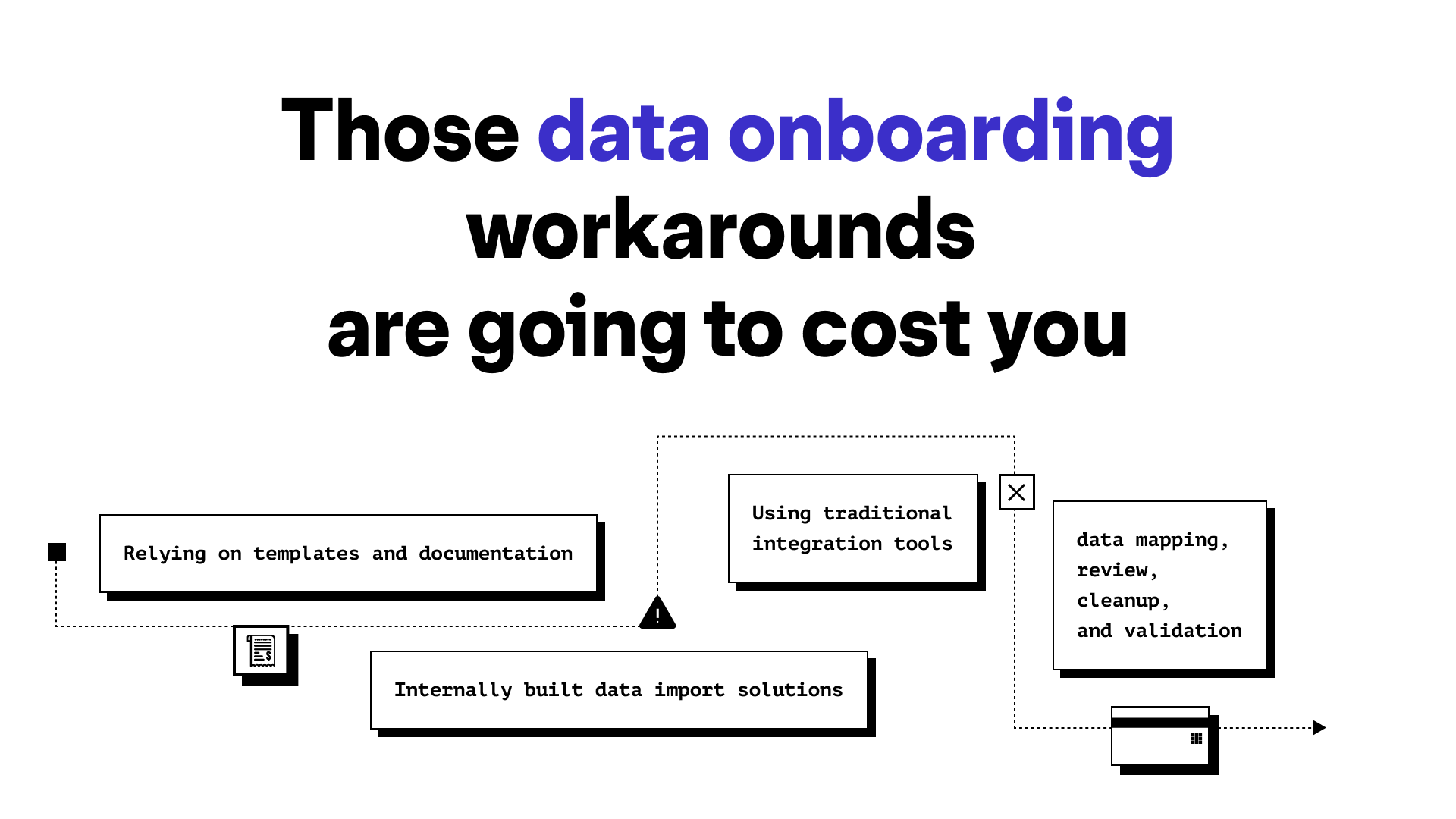CS leaders: Those data onboarding workarounds are going to cost you

Becca Weiss
Director of Customer Success & Implementation
Share to

We know data onboarding can be a nightmare.
How bad that nightmare is depends on the solutions you have in place.
There are a lot of ways companies try to tackle data onboarding problems like files that refuse to cooperate, incompatible data formats and the countless hours it takes to manually clean data. Usually, teams are tasked with creating and implementing complicated workarounds. Those workarounds, however, come at a high cost. Personnel and manual work costs, supporting engineering resources and long-term maintenance are just the tip of the iceberg. The opportunity cost of lost and delayed revenue can be millions of dollars.
Data onboarding shouldn't hurt
Download our free guide to discover how CS leaders can address data onboarding challenges and help new customers become customers for life.
What’s wrong with data onboarding workarounds?
Data mapping, review, cleanup and validation often aren’t easy to handle, and there are several common ways CS leaders attempt to solve data onboarding complications. These workarounds include:
Why don’t they work? Keep reading to find out.
Using traditional integration tools
Data integration and management tools have been around for decades, but they aren’t designed to support the data onboarding and data migration use cases that CS teams struggle with every day. Traditional ETL (Extract Transform Load) and iPaaS (integration Platform as a Service) solutions are built on the idea that data is only ever safely and securely transferred between tightly managed IT systems. Unfortunately, they ignore the reality that data is messy! The data you need from your customers will often require complicated data mapping, review, cleanup and validation before it can be migrated and imported into your target system. Additionally, data often needs human review and oversight, which may involve deeper collaboration between the CS team and the customer.
Relying on templates and documentation
One popular solution that companies rely on to address data onboarding challenges is providing pre-made templates to customers and having them manipulate their data to fit a specific, fixed data model before uploading. In this scenario, an end user handles the work, but your organization needs to provide documentation, tutorials, FAQs and other how-to documents to walk a customer through the data import and migration process.
Companies often ask users to adhere to one very specific spreadsheet format, and even the slightest deviation from that format results in the rejection of the data import attempt. Unfortunately, after the second or third attempt, users become highly frustrated, which can make an already challenging situation even more difficult. The impact of this process on customer satisfaction, conversion rates and missed top-line revenue is one of the most overlooked issues in data integration.

Do data onboarding templates waste customer time?
One team found that their customers were experiencing significant upload failures with their data files, which caused delays and required client operations and IT to get involved to solve the issues. They ended up spending a lot of time going back and forth with many of their customers, having them fix their files and resend them.
If the data migration experience is manual and your process relies heavily on templates and on customers to update and fix files for onboarding, it may be time to reevaluate and examine how much time and energy are being dedicated to the process.
Internally built data onboarding solutions
Initially, many teams gravitate toward building their own solutions for importing data files, filtering data, flagging anomalies and correcting information. At first glance, this might seem like a practical choice that offers the most control over the finished product and frees up data management resources. Unfortunately, custom solutions introduce their own set of difficulties. As many CS leaders already know, if you're dealing with non-trivial needs, a homegrown solution often ties up limited and expensive resources, introduces dependencies on other internal teams with different priorities and usually costs more in the long run.
Many companies are convinced that building internally is necessary due to their unique data onboarding requirements, but it's becoming increasingly rare that companies actually need to build data import capabilities on their own. Enterprise-scale data onboarding solutions are built to address different organizations' varied needs. They're created and maintained to enable flexible workflows and configurations, and they bottle up the experience of domain experts, which is impossible to develop in a one-off project.
Data onboarding isn’t a set-it-and-forget-it process. The business and your customers will require ongoing enhancements and maintenance of your data onboarding solution. Any team that takes on the responsibility of building a solution is also committing to support and maintain it over time. It typically becomes the responsibility of the team that created it and this ongoing maintenance is almost guaranteed to be a distraction from the core business functions that attracted your customer in the first place.
The simple solution
Once you analyze your customer onboarding process, you may find it difficult to implement the necessary improvements, especially at scale. You might need to find the right balance between truly personal one-on-one onboarding and automated processes.
A data file exchange platform like Flatfile is the easy painkiller for your data onboarding headaches. It’s designed to help you build the ideal data onboarding experience for your use case and requirements. Flatfile is a collaborative, secure data exchange platform that helps companies speed up every part of data migration, from data submission to cleaning, mapping, validation and transformation.
You spent the time, energy, and resources to acquire a new client. If you can help them find value quickly and easily, your team will have a much easier time of keeping that customer for life, and you’ll have a customer onboarding experience that can set your software apart from the competition.
Watch Flatfile in action
We can help you spend 70% less time onboarding data. Discover how


